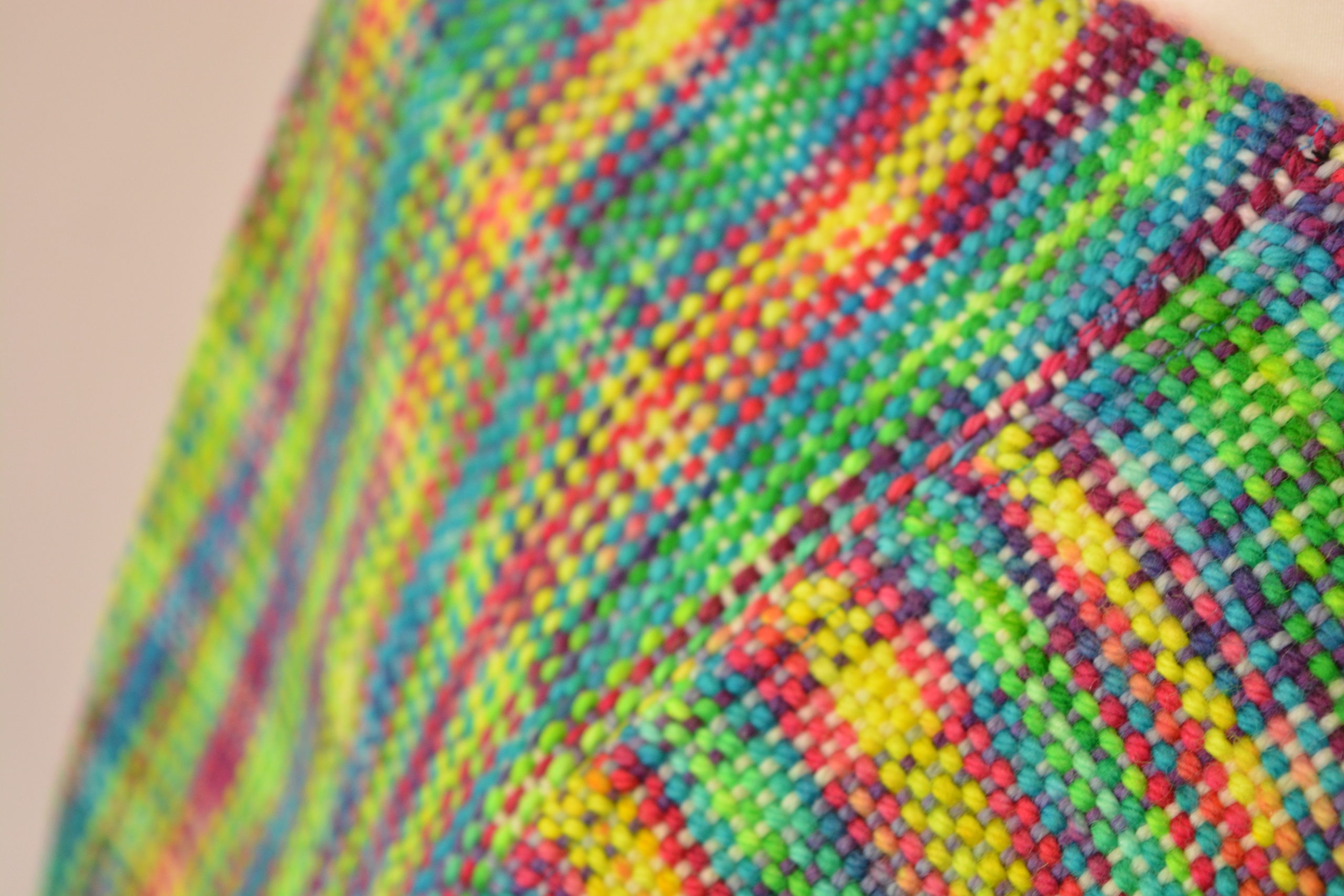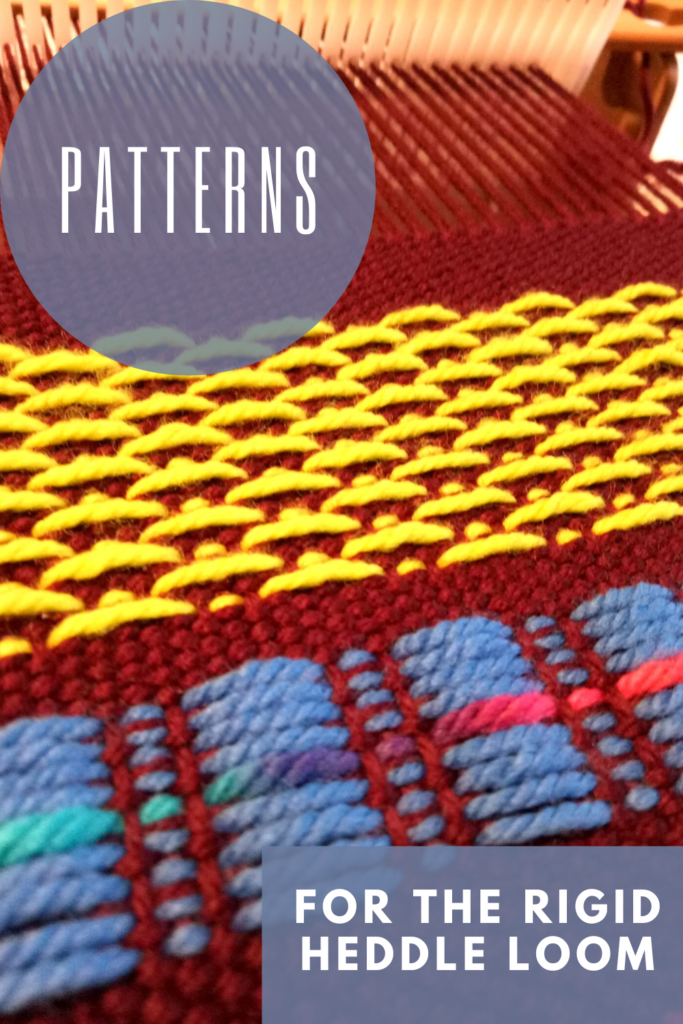It is sometimes presumed that the rigid heddle loom is a plain weave loom. This is because, at it’s most basic, it is a two shaft loom, and plain weave is woven on two shafts.
While it’s true that plain weave is often woven on a rigid heddle loom, it’s capabilities for weaving patterns can be surprising (and very pleasing to the newer weaver!)
Plain weave is very simple on a rigid heddle loom and easy to set up. Thread one slot and one hole alternating for the width of your project, then when weaving alternate the heddle between the up and down position, and you’re on your way!
*This post contains affiliate links. For more information, please see my disclosure policy.
After a plain weave project or two (or three or four!) weavers often want to know “what is next?” Can I do anything else?
The question that I have come to challenge myself with more in recent times is “is there anything I can’t do on a rigid heddle loom?” Yes, it’s really that capable.
An easy way to jazz up your plain weave so that it looks patterned is to use a variegated yarn. Whether you dye your own or buy a commercially dyed variegated, it’s a really cool effect that makes the plain weave look much more involved.
You have two options with this technique. You can either warp with the variegated yarn and weave with a solid colour or warp with the solid colour and weave with the variegated.
Here are a couple of examples of commercial variegated yarns:
Then there is clasped weft! Once again, we have plain weave but with the use of colour and some clever techniques, you can create distinctive and unique patterns. Pairing variegated and solid yarns works very well for clasped weft.
It lends itself beautifully to almost any woven items you can think of, so warp up and start experimenting!
Here is a beginner’s video on where to start with clasped weft:
I also have videos on clasped weft with 3 colours and 4 colours, but if you’re just starting out with it, I recommend you go through this one first to get the concept set in your mind.
The most logical next step up from plain weave is the introduction of pick up sticks. These are simple, effective and inexpensive flat sticks of timber with usually tapered ends that assist in the picking up of the threads. Some people who are handy with wood even make their own.
The things I really love about pick up sticks are:
- You don’t really need to know what you’re doing in order to start using them.
- They are a very affordable way to change and advance your weaving skills.
- They can radically change your woven piece.
Check out this video or this detailed article on how to use pick up sticks:
There is just so much you can do with one, two or more pickup sticks. Besides picking up behind the heddle to weave patterns, you can also pick up at the front to weave a type of overshot. This is where your pattern will sit on top of the background weaving rather than being incorporated in (this is called a float). If you arrange your floats and colours in particular ways, you can weave all sorts of cool patterns!
I have a lot of these overshot style videos on Youtube, but considering the Christmas theme is so loved, here are a couple of the most popular videos:
This is intended to be a brief overview of pattern weaving on a rigid heddle loom, there is so much more! I haven’t touched on Colour and Weave here, as it deserves it’s own post. You can read more about Colour and Weave in this article. I have, however written about plaid and made some free drafts for your use. You can read that post here.
You can find even more resources for weaving more stunning patterns in this post where I take you through techniques like doubled weft, pick up rows, staggered pick up, dots and butterflies. So many possibilities!
I do hope that this has given you some ideas on where to start when you want to level up from plain weave.
If you are just starting out with rigid heddle weaving, I highly recommend my beginner’s online class From Woe to Go! It takes you step by step through everything you need to get up and weaving.
Until next time…
Happy Weaving!





Kelly, do you find you use more 4 ply or more 8 ply yarn when making scarf’s.
I prefer 4ply (fingering weight) but it’s definitely a personal preference.
I can’t wait to try all these techniques! Your videos are paced well with clear instructions. Do you have a video or article about different types of yarn, which ones work best and how they might change the look of your project?
I have quite a few yarn resources-
Choosing and using yarns in weaving – http://kellycasanovaweavinglessons.com/2020/03/choosing-and-using-yarns-in-weaving.html
Knitting and weaving yarns- http://kellycasanovaweavinglessons.com/2021/12/what-is-the-difference-between-knitting-and-weaving-yarn.html
Yarn weights – http://kellycasanovaweavinglessons.com/2020/01/which-weight-of-yarn-do-i-choose.html
Best yarn for towels- http://youtu.be/X_v2Q-z5W_o
Which cotton yarn should I use? http://youtu.be/biB7Uqm2uB8
Which yarn is best for scarves? http://youtu.be/r7cZpEguK98
Wonderful video, just curious if clasped weaving works, or what the result is like if you do this for a scarf leaving a little blooming space in between for drape?
Hi Jen, I guess it would depend on how much space?
Hi Kellly….hope all is well with you and your’s. I purchased “Crazy Shot by Myra Wood. What wonderful patterns. Can I use these designs on my Schacht 15″ loom or my 30” loom? Are more than one Heddle necessary?
Have a nice day.
Dottie from Florida
Hi Dottie,
Yes, you can weave the designs on your Schacht looms, just check the size you need for each project. You only need one heddle 😊
I’m quite new to weaving this year I would like to try tea towels with lettering on one edge is this possible with a RHL?
Yes, to some extent it’s possible. I haven’t really tried it myself.
Hi Kathy, Retired RN, moved to Tucson, AZ 10 yes ago. Met some girls, who where fiber fanatics, spining,weaving, twirling, chasing sheep, you get the 📷!!!. Started taking classes. Weaving interest me. Learned on asford, store sold me a cricket, hated it. Lost interest. 2 years later, last week I started again, with the help of old notes and some d pics from the net completed, what could be any number of things. Many, many mistakes. Watching utube on TV, I came across u and remembered I had subscribed to your channel. Thank Goodness your still out there. My question concerns the header, didn’t do one. I now know why its needed, lol. Is it part of the project, meaning does it stay or is it removed at the end of the project ? Is it added in, when u are determining how much warp yarn u Need? 🤔 Do you use thinner or thicker yarn, and does the color have to match the project colors.
I await your response. Going to go thru my stash, and try to determine which color goes well with what. Don’t want to buy new until I use the old. Have a good day. STAY SAFE
to
I don’t use yarn for a header, I use cardboard separators – I find that quick, easy and effective. Insert one separator in an up shed, next one in the down shed, beat and you’re good to go. When your project comes off the loom, you whip the cardboard out, easy.
But, if you want to use a yarn header – yes, most people use a slightly thicker yarn, it is calculated into the waste allowance when you do your initial calculations. If using yarn, it is not part of the project, it gets removed at the end when you take your piece off the loom.
Hope that helps!
Hope that helps!
Hi Kelly, sorry I changed your name, Thanks for the reply. I’ll be using the the cardboard. I will also be registering for some of your classes, just not sure where to start.
Thanks Marie!
Hi Kelly, watched your video on slow learners last night, which helped me make up my mind about enrolling in your courses, but first a couple of questions. Please forgive me if they sound idiotic. First. I’ve watch so many of ur videos on YouTube and it appears that many of them are courses in ur school, so why do u charge for them? 2nd. In the classes, do u start from the basic beginning or do you just skip around. I need step by step and the ability to repeat the video if necessary and to get help from u if I’m still having trouble understanding eg calculations..3. I already have an 8 dent cricket, will I be able to use it during your course. I really don’t want to have to buy another. The yarn/ thread is not a problem. I want to do it all!! But like you said, I need to take a slow down pill and learn the basics, than work my way up to the more exciting aspects of weaving . Lastly, does the subscription to ur newsletter come with membership or it separate.
Hi Marie,
1. Some of my Youtube tutorials are available in my Online Weaving School as free classes as some people prefer to view them there. Most of my classes are actual classes and not available on Youtube. Also, if you purchase a membership, you get to join the member’s group, leave comments in the classes and receive additional email support from me.
2. There are all different classes for all different levels. If you need a beginner’s class, the Woe to Go Beginner Rigid Heddle class is perfect. All of my students receive personal support from me if they need it.
3. Yes, your Cricket with an 8 dent is fine, many of my students use the same. My loom has a 7.5 dent heddle but the projects are easily adjusted. You may find as you go along that you want to add some other heddles to your collection – I find a 10 dent is particularly helpful.
My newsletter is separate to the Online Weaving School memberships. The newsletter is free to sign up to.
I hope this answers your questions, but feel free to ask for further clarification if you need it 😊
I am a new rigid heddle weaver and I am looking for instructions on how to read a weaving draft/chart. Can you help me?
Hi Kathy,
I do have a class on how to read weaving drafts, but it’s a members only class. Are you looking for information or reading a rigid heddle draft or more complicated draft?
Hi Kelly,
Excellent post on “Rigid Heddle Weaving Patterns for Beginners” and is especially great how encouraging your post is!
A very minor comment: The commercial variegated Red Heart yarn that’s linked to in this post is “Heart & Sole” instead of “Jellybeans”, which is one of the color names for the Red Heart – Heart & Sole yarn.
Happy weaving, Jude
Thanks for pointing that out Jude!
What great information! And all in one place. I began my weaving journey in May and because of you and your lessons, it’s been a very productive 7 months. I’ve surprised myself with what I’ve learned and accomplished. Thank you so much, Kelly, for sharing your expertise with the weaving community!
Great to have you along on the journey Terri!